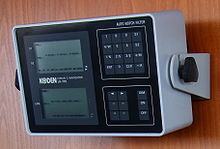
Loran-C is a hyperbolic radio navigation system that allows a receiver to determine its position by listening to low frequency radio signals that are transmitted by fixed land-based radio beacons. Loran-C combined two different techniques to provide a signal that was both long-range and highly accurate, features that had been incompatible. Its disadvantage was the expense of the equipment needed to interpret the signals, which meant that Loran-C was used primarily by militaries after it was introduced in 1957.
By the 1970s, the cost, weight and size of electronics needed to implement Loran-C had been dramatically reduced because of the introduction of solid-state electronics and, from the mid-1970s, early microcontrollers to process the signal. Low-cost and easy-to-use Loran-C units became common from the late 1970s, especially in the early 1980s, and the earlier LORAN[a] system was discontinued in favor of installing more Loran-C stations around the world. Loran-C became one of the most common and widely-used navigation systems for large areas of North America, Europe, Japan and the entire Atlantic and Pacific areas. The Soviet Union operated a nearly identical system, CHAYKA.
The introduction of civilian satellite navigation in the 1990s led to a rapid drop-off in Loran-C use. Discussions about the future of Loran-C began in the 1990s; several turn-off dates were announced and then cancelled. In 2010, the US and Canadian systems were shut down, along with Loran-C/CHAYKA stations that were shared with Russia.[2][3] Several other chains remained active; some were upgraded for continued use. At the end of 2015, navigation chains in most of Europe were turned off.[4] In December 2015 in the United States, there was also renewed discussion of funding an eLoran system,[5] and NIST offered to fund development of a microchip-sized eLoran receiver for distribution of timing signals.[6]
United States legislation introduced later, such as the National Timing Resilience and Security Act of 2017, proposed resurrecting Loran.[7][8]
- ^ Hefley 1972, p. xi..
- ^ Cite error: The named reference
USCG LORANwas invoked but never defined (see the help page). - ^ Cite error: The named reference
canwas invoked but never defined (see the help page). - ^ "Loran off air in most of Europe move to commercial possible". Resilient Navigation and Timing Foundation. 4 January 2016.
- ^ Divis, Dee Ann (10 December 2015). "PNT ExCom Backs eLoran as a Step to Full GPS Backup System". Inside GNSS (January/February 2016).
- ^ "Will fund eLoran on a chip — NIST". Resilient Navigation and Timing Foundation. 11 February 2016.
- ^ Martin, Aaron (19 December 2017). "Senate bill would require establishment of land-based alternative to GPS satellite timing signals". Homeland Preparedness News. Archived from the original on 15 January 2018.
- ^ "Coast Guard Authorization Act of 2017".
Cite error: There are <ref group=lower-alpha> tags or {{efn}} templates on this page, but the references will not show without a {{reflist|group=lower-alpha}} template or {{notelist}} template (see the help page).
© MMXXIII Rich X Search. We shall prevail. All rights reserved. Rich X Search
